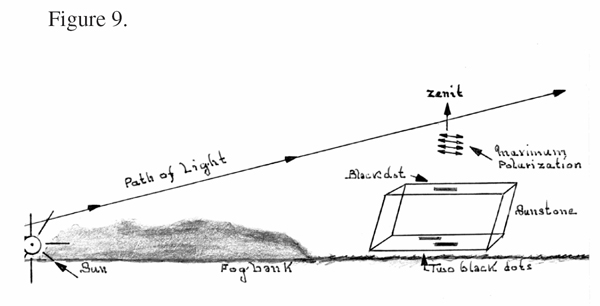The Viking Sunstone
Is the legend of the Sun-Stone true ?

Bees do it. Ants do it. Did the Vikings do it? Can it be that the Vikings used the polarization of skylight as a navigation compass? Did the Vikings find their way to America by looking at the sky through a crystal, the proverbial sunstone?
The Icelandic sagas tell the story of how the Vikings sailed from Bergen on the coast of Norway to Iceland, continuing to Greenland and, likely, Newfoundland in the American continent. This remarkable sailing achievement was realized circa 700 AC, before the magnetic compass reached Europe from China (it wouldn't have helped much, anyway, so close to the Magnetic Pole). How did they steer true course in the long voyages out of land sight, especially in the common bad weather and low visibility of those high latitudes?
In 1667, a Danish archaeologist, Thorkild Ramskou, suggested that the Vikings might have used the polarization of the skylight for orientation when clouds hid the sun position. They would have used as polarizers natural crystals available to them, the famous sunstones described in the sagas. To find the location of the sun they only needed a clear patch of sky close to the zenith to determine the great circle passing through the sun. The pros and the cons of this theory are the following.
In favor:
- The sagas mention a sun-stone.
- The crystal cordierite can be found as pebbles in the coast of Norway. It has birefringent and dichroic properties, changing color and brightness when rotated in front of polarized light. With an adequately cleaved crystal it is easy to tell the direction of skylight polarization: its color will change (e.g. from blue to light yellow) when pointing towards the sun. [Curiously enough, the Vikings frequented Iceland, the first source of Iceland Spar (optical calcite), which has had such an important role in the discovery and study of polarization. Even today, many high-performance polarizers use that mineral]
- At high latitude the sun remains for a long time close to the horizon, which produces the best skylight polarization pattern for navigation purposes.
- Because of perspective, a bank of clouds of uniform density is squeezed together when looking far away. Thus, it is usually much easier to find a clear patch of sky towards the zenith (just try it). And crepuscular rays (the beams of light and darkness radiating from the sun when blocked by clouds) are difficult to see close to the zenith, as the line of sight crosses them through their thinnest section.
- The method would have worked even when the sun was several degrees below the horizon (but still illuminating the atmosphere). Note that at twilight, when the sun is below the horizon by about two degrees, its location is very difficult to ascertain. Although a bright twilight arch can be seen, it occupies a large part of the horizon and is of uniform intensity. A similar effect may conceivable happen when the sun is above the horizon and a thick layer of clouds covers it.
- Light fog and overcast of thin clouds don't eliminate skylight polarization.
Against:
- The sagas don't mention the sunstone in relation to navigation or sailing (although some people point out that a word usually translated as "bewildered" (hafvilla) appears describing voyages beset by fog or bad weather, this is too weak a relation). In fact, little detail is given to identify the sunstone.
- The navigation season was, of course, summer when the sun is not that low during good part of the day nor is the weather very bad.
- In all likelihood, the Viking sailor would have used a large number of clues from the sea and the sky to steer his ship. In many cases he could have interpolated the position of the sun between sightings or estimated its position. Many times it suffices to look at the pattern of illumination of the clouds, their iridescence, the direction of crepuscular rays or, close to twilight, the general illumination of the sky. Furthermore, the knowledge of the sun position is not sufficient for navigation. The helmsman needed to correct the sun direction for the time of the day and day of the year. Thus, he must have been quite a good reader of the sky and the sea.
- Under a heavy overcast sky, when a navigational aid would be most useful, the polarization method doesn't work.
- This theory is just a possibility, a statement of what the Vikings could have done, but it is based only in circumstantial evidence.
Interestingly, in the late 40's the US National Bureau of Standards (now NIST) developed a Sky Compass based on the same principle. It was inspired by a previous "twilight compass" developed by Dr. A. H. Pfund of Johns Hopkins University. From a NBS 1949 paper: "The principal advantage of the sky compass . . . is during twilight, and when the sun is several degrees below the horizon, as well as when the region of the sky containing the sun is overcast, so long there is a clear patch of sky overhead. The sky compass is thus of particular value when the sun compass and the sextant are not usable. Since the extent of polarization of the sky's light is greatest at right angles to the incident beam of sunlight, the compass is most accurate in the polar regions, where it is also most useful, because of the long duration of twilight . . ."
When Ramskou originally proposed this theory, it was well received and widely accepted by the general public and also by the scientific community, and remained so for more than two decades. The Viking navigational triumphs became very fashionable, especially the exploits of Eirik the Red circa 1000 AC and the "discovery" of America centuries before Columbus. Scientific American and National Geographic magazines carried the story of skylight navigation. However, in the 90's the theory was disputed on the basis that no real material proof exists and that the advantage provided to navigation would have been marginal. My personal take is that polarized skylight could have been of real use to the Vikings but, until direct evidence is found, one should be skeptic and stick to the simplest explanation: that the Norsemen where damn good sailors!
However, the image of the Vikings in a quest of faith into mysterious and dangerous seas, following west the light from the sky viewed through a magic crystal, has its obvious romantic appeal . . .
Some references
T. Ramskou, "Solstenen," Skalk, No. 2, p.16, 1967 (Ramskou's original publication, but I haven't read it)
"Sky Compass," Review of Scientific Instruments, Vol. 20, p.460, June 1949
H. LaFey, "The Vikings," National Geographic, Vol. 137, p.528, 1970
R. Wehner, "Polarized-light navigation by insects," Scientific American, Vol. 31(1), p.106, 1976
Curt Roslund and Claes Beckman, "Disputing Viking navigation by polarized skylight", Applied Optics, Vol. 33, No. 21, p.4754, July 1994.

